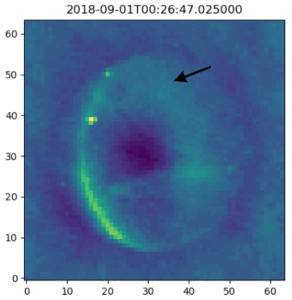For the last three months I have been living in the United States in Phoenix, Arizona working on implementing a novel real-time imager for a radio telescope that is capable of imaging the radio sky in real-time, something which is nominally not feasible because of the high data rates involved.
This is done through a slight modification of the mathematics involved, which has the convenient side effect of also scaling as \( O(nlog(n)) \) compared to \( O (n^{2}) \).
Instrumental benefits aside, this leads to some pretty cool science:

This is a meteor hitting the upper atmosphere being imaged in real-time at 25ms cadence between frames. The impact with the atmosphere creates a plasma bubble which reflects the light being transmitted by a TV tower around 55 MHz. A good example of where radio frequency interference can actually be of benefit!
The high performance streaming implementation which creates the above images was created primarily by myself, based on the Bifrost framework. Bifrost is a python library which interfaces to high performance C/C++ and CUDA code and allows high throughput streaming systems to be built very quickly and effectively. I finished the project in two months, constituting a whole PhD chapter! Jayce Dowell also helped significantly, having previous expertise with Bifrost.
The source code is available here: LWA EPIC
My personal Bifrost fork with some critical modifications including a high performance convolution algorithm for CUDA is available here: My Bifrost Fork. Edit 13/4/2020: There has been major work done on the Bifrost implementation and it has been transferred to a new epic-astronomy GitHub team here: EPIC-Astronomy Team
Many thanks go to my supervisor Bojan Nikolic, as well as Nithyanandan Thygarajan and Adam Beardsley at NRAO and ASU for facilitating the project. Jayce Dowell at the University of New Mexico contributed significantly with his LWA expertise and prior Bifrost experience.
A paper will be written shortly, as well as a thesis chapter.